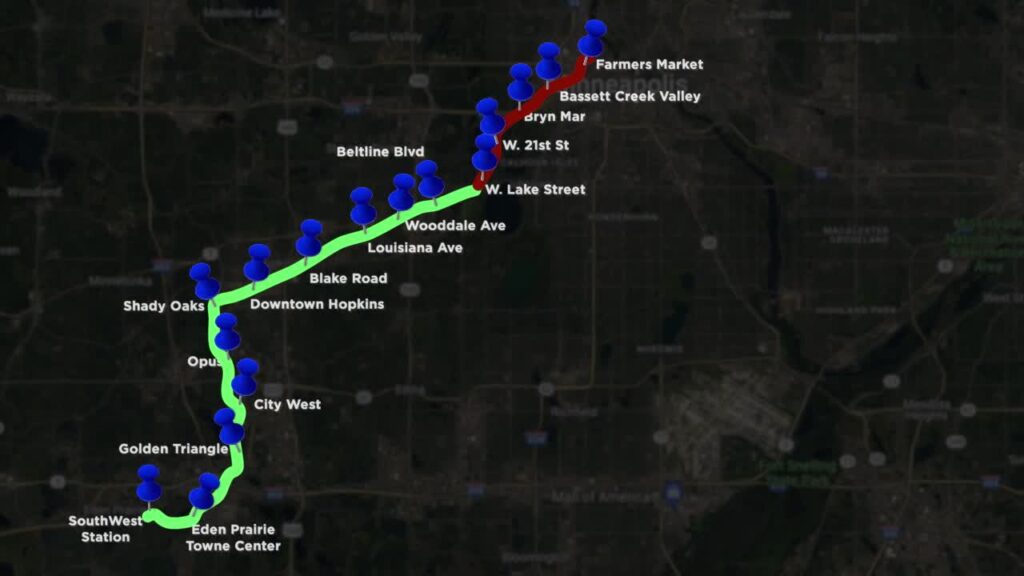New problem uncovered on notorious ‘pinch point’ for Southwest Light Rail
A new section of light rail tracks is about a foot too close to existing freight tracks in Minneapolis. That discovery is the latest hiccup for the controversial Southwest Light Rail project, which is already years behind schedule and more than $1 billion over budget.
The Metropolitan Council recently confirmed the discrepancy to 5 INVESTIGATES after homeowners on West 21st Street raised concerns about construction not following the project’s stated design plans.
“24 feet”
Marion Collins is among those living just steps away from the Kenilworth corridor where the Southwest Light Rail, also known as the Green Line Extension, is adding two new sets of tracks to an area that already includes freight rail carrying hazardous materials such as ethanol.
“That’s where all of us that live all along the corridor here started to get really worried,” Collins said. “We were like, ‘We have a corridor here that is very narrow, so what is the plan for keeping us safe and keeping freight rail and light rail separate?'”
In an email to Collins, Metro Transit cited its “design criteria” for the project and stated, “the centerline of the freight track and centerline of the closest LRT track will be 25 feet apart.”
But when crews recently laid the new light rail tracks at the crossing on West 21st Street, Collins and her neighbors measured the distance and found they were about one foot too close to the freight tracks.
“Everybody’s coming up with 24 feet,” Collins said. “They have all the equipment, they have all the specialists, they have surveyors – how did they get this wrong?”
Jim Alexander, project director for the Green Line Extension, acknowledged the issue during an interview with 5 INVESTIGATES.
“I have always understood that we have 25 feet there, so we’re talking to our engineer to understand, ‘OK what happened? What’s going on?'” Alexander said. “Because we measured it as well… we’re showing about seven inches short of the 25 feet.”
$2.86 Billion
Alexander added that Metro Transit is now in the process of finding a “resolution,” but he would not predict what it will take to increase the distance between the light rail and freight rail tracks at the crossing in question.
“First of all, we’re still working out there,” Alexander said. “We’re not done yet.”
West 21st Street is among five remaining stations still under construction on the Southwest Light Rail route, which includes 16 stops between Minneapolis and Eden Prairie.

In January, Alexander told Met Council members the estimated price of the 14.5 mile Southwest Light Rail had grown to $2.86 billion. That’s more than $197 million per mile.
As 5 INVESTIGATES previously reported, managers blamed much of the cost overruns and delays on another section of the Kenilworth corridor where Metro Transit had to build a tunnel and a crash wall to separate light rail from freight trains.
It is unknown how much more it will cost to address the new problem, about a mile away, at West 21st Street.
Alexander called it a “small issue,” but he acknowledged that homeowners in the area may not see it that way.
“I feel for the neighbors. We’ve been working out there for quite some time. They’re nervous. I know that and we’ve been hearing that,” Alexander said. “But we think we are building a safe system here and we’ll get this right.”
Safety at the “pinch point”
Frustration over the latest problem with Southwest Light Rail extends beyond those living along the Kenilworth corridor.
The tracks in question are in the middle of state Rep. Frank Hornstein’s (DFL-Minneapolis) district.
“This continues to be a vexing issue. It just seems there’s one thing after the other, after the other,” said Hornstein, who has called out the Met Council in the past for what he and others described as a lack of accountability.
“I think there’s a larger issue here, of being careful in how this is being done. And that should have been checked and double checked and triple checked and apparently it wasn’t,” Hornstein said.
The original plans for Southwest Light Rail called for the freight tracks in question to be relocated, but that plan was eventually scrapped and the project moved forward with co-locating light rail and freight in the Kenilworth corridor.
Twin Cities & Western Railroad relies on those rails to transport more than $1 billion in goods to and from St. Paul every year, according to Mark Wegner, president and CEO of TC&W.
“It was recognized that in that corridor, it’s what they would call a pinch point,” Wegner said. “So we just need to make sure that all the engineering with sound and that there would be no danger of any incidents involving a freight train and a light rail train.”
Not OK with “close enough”
Wegner told 5 INVESTIGATES he was unaware of the new questions about the distance between light rail and freight tracks, but his company is working with its own independent engineer to investigate any issues that arise.
“It’s in everybody’s best interest to make sure all the safety redundancies in a track structure for freight rail are followed to a T,” Wegner said. “So basically, no surprises and no derailment issues.”
Wegner added that separating light rail and freight rail by a minimum of 25 feet is largely to protect workers when they are in the area.
Homeowners insist they just want Metro Transit to keep its word, even if the measurements are off by less than a foot.
“I get it – it sounds like it’s not very much… but the distance is not very much,” Collins said. “I’m a physician and if I was like, ‘well, it’s close enough,’ that could cost somebody their life.”